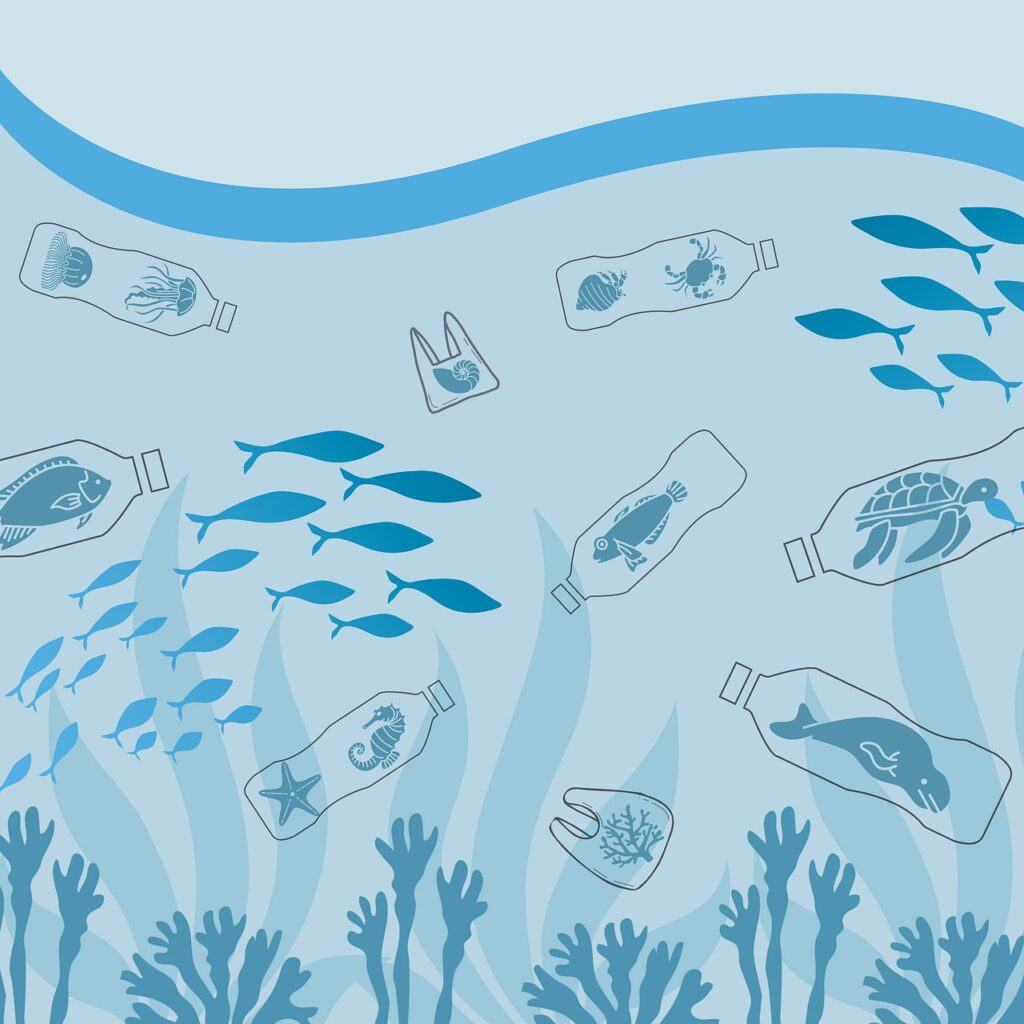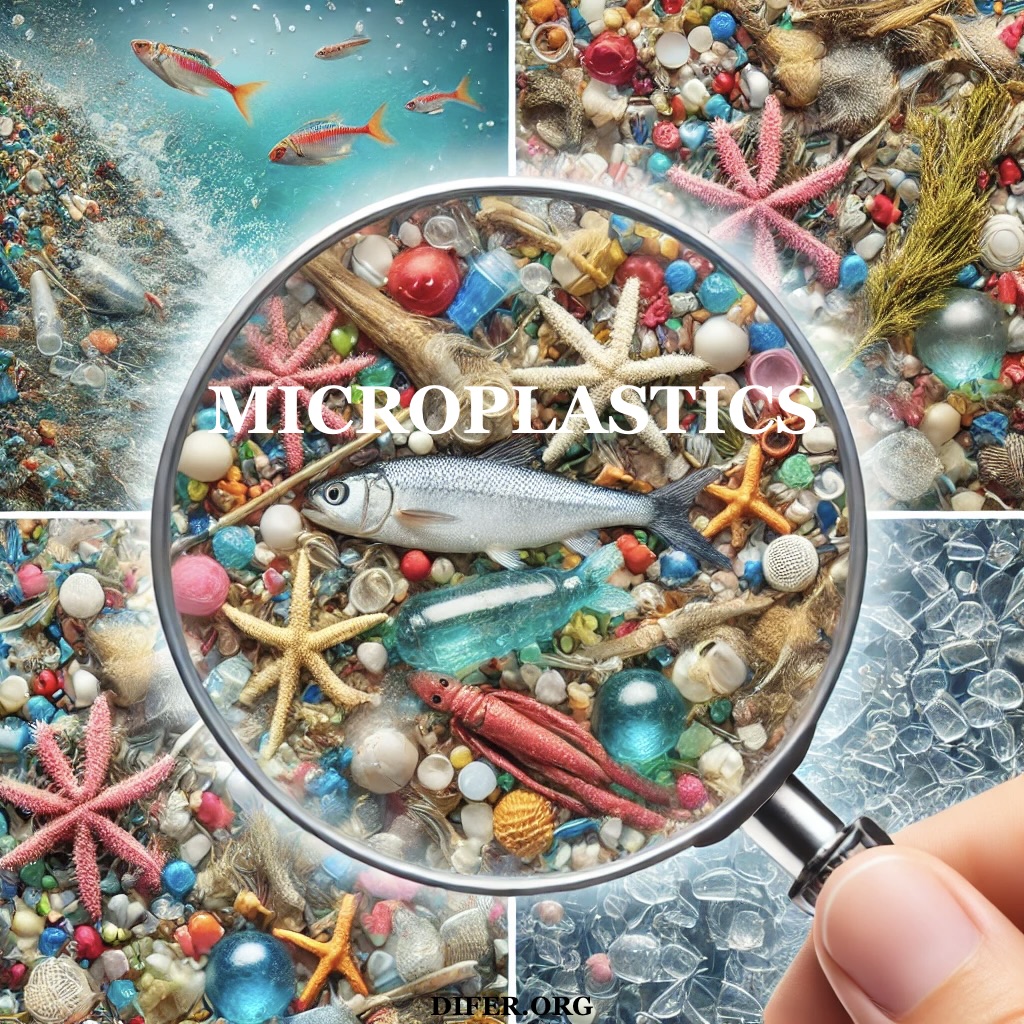Plastic is one of the most widely used materials in the world with its versatility and durability making it a convenient choice for countless products and applications. However, the downside of this widespread use of plastic is that it is not biodegradable and can persist in the environment indefinitely. A particularly worrying form of plastic pollution is microplastics, which are small plastic particles measuring less than 5mm in size. These tiny particles are everywhere, from our oceans to the air we breathe, impacting our environment and health.
Sources of Microplastics
Microplastics are created through a variety of processes, including the breakdown of larger plastic items and the release of small plastic pellets used in the production of plastic products. They had also been added to personal care products, such as toothpaste and exfoliating scrubs, and are frequently found in synthetic clothing and other textiles. When these items are washed, the microplastics are released into the environment and eventually find their way into our oceans, other waterways, and can also be found in the fertilizer used to produce our food.

Impact on the Ocean and Marine Life
The oceans are particularly vulnerable to the effects of microplastics, as they can easily be transported by ocean currents and carried great distances. Once in the ocean, microplastics can have a profound impact on marine life. Small organisms, such as zooplankton, can mistake the particles for food and ingest them, which can lead to malnutrition and death. Larger species, such as sea turtles and whales, can also be affected, either by ingesting the particles or becoming entangled in plastic debris.
Microplastics can also act as a sponge for toxic chemicals, such as persistent organic pollutants (POPs), which are known to have harmful effects on wildlife and humans. When marine species consume these contaminated microplastics, they are exposed to these toxic chemicals, which can accumulate in their tissues and lead to health problems, such as reproductive failure and immune system suppression. Additionally, microplastics can provide a habitat for harmful bacteria, viruses, and parasites, which can negatively impact the health of marine species.
Also, microplastics are believed to contribute to the decline of biodiversity and the destruction of natural habitats. They can physically entangle and kill wildlife and alter the balance of ecosystems.

Impact on Human Health
Another major concern is the effect of microplastics on water quality. Microplastics can persist in the environment for hundreds of years, making it nearly impossible to remove them from our waterways and oceans. The presence of microplastics in our oceans and waterways is not just a problem for marine life, but also for human health. They have been found in tap water, bottled water, and even in the air we breathe, posing a potential threat to human health. As the particles make their way up the food chain, they are ingested by seafood that we eat, and have enter the human food chain.
Microplastics are also negatively impacting soil. Plastic particles have been found in soil samples, and studies have shown that they can reduce plant growth and impair the fertility of the soil by increasing the soils pH and decreasing microbial activity. Additionally, they have been shown to affect the rooting ability of plants by altering soil bulk density and water-holding capacity, as well as reducing photosynthetic rate.
There is also growing concern about the potential inhalation of microplastics, as the tiny particles are small enough to be inhaled into the lungs. Microplastics may even be small enough to pass the blood brain barrier negatively impact the microglial cells in the brain. Microplastics can have carcinogenic and mutagenic properties, meaning they potentially cause cancer and can damage DNA. There are countless potentially toxic chemicals that can leach from plastics and enter our bodies causing numerous in our health and environment. Plastics do not readily break down into harmless molecules, and they can take hundreds or thousands of years to decompose.

How to Reduce Microplastics
There are many actions individuals can take to reduce their own contribution to the problem of microplastics:
- Think About Our Consumption: We can choose to make different choice and consume less. Every choice we make has a consequence. Even simple decisions like driving have an impact. Tire dust is a significant contributor to microplastics in our environment. Even the clothing we choose to wear produces microplastics.
- Reduce Plastic Use: The most effective way to reduce the amount of microplastics in the environment is to reduce our overall use of plastic. This can be done by choosing reusable options, such as reusable water bottles, bags, containers, and avoiding single-use plastics.
- Choose Products Wisely: When shopping, pay attention to products that contain plastics and choose alternative options, such as those made from natural materials.
- Support legislation: Governments can play a role in reducing the release of microplastics into the environment by passing laws and regulations that restrict the use of microplastics in products and require companies to properly dispose of plastic waste.
- Hold Companies Responsible for the Waste They Produce: Companies should be held responsible for their contributions to the production of microplastics. We can use our power as consumers to make better choices and choose not to support companies that use plastics in their products.
Conclusion
Microplastics are a growing concern for our oceans and environment, as they have the potential to harm wildlife and human health. The negative impact of microplastics on the environment is widespread and far-reaching. It is crucial that we take steps to reduce our use of single-use plastics and properly dispose of the plastic we do use to minimize the spread of microplastics in the environment. Microplastics can persist in the environment for hundreds of years, making it nearly impossible to remove them from our waterways and oceans. By greatly reducing our plastic use and supporting legislation to limit the release of microplastics into the environment. We collective have the power to make a difference.
For ways to help avoid microplastics to help the environment and save money, please read: Eco-Friendly Ways to Save
Sources:
- Marine Conservation Society. (2021). Microplastics in the marine environment. https://www.mcsuk.org/what-we-do/microplastics
- National Geographic. (2021). Microplastics: What they are and why they matter. https://www.nationalgeographic.com/environment/oceans/critical-issues-ocean-plastics/
- United Nations Environment Programme. (2021). Microplastics in the environment. https://www.unenvironment.org/explore-topics/pollution/what-microplastics
- World Wildlife Fund. (2021). Microplastics. https://www.wwf.org.uk/updates/microplastics
- NIH: National Library of Medicine. (2022). Research progress of microplastics in soil-plant system: Ecological effects and potential risks https://pubmed.ncbi.nlm.nih.gov/34742990/#:~:text=Microplastics%20have%20been%20shown%20to,chlorophyll%20a%2Fchlorophyll%20b%20ratios.
DIFER.ORG supports efforts to reduce the use of plastics
Please read “FACTS about MICROPLASTICS” for more information about Microplastics including guide to reduce waste:
Facts about Microplastics
Take action today to let leaders know that you support no plastic in nature.
Please Share this Information

DIFER is dedicated to making a difference






Pingback: The Perils of Plastic Bottles – DIFER.ORG
I’m into blogging and i really appreciate your content. The article has actually peaks my interest. I’m going to bookmark your web site and maintain checking for brand spanking new information.
Awesome! It’s genuinely remarkable post. I have a much clearer idea regarding microplastics from this post
I really like reading through a post that can makes men and women think.
Pingback: Green Ways to Save Green: Eco-Friendly Ways to Save Money – DIFER.ORG
Pingback: Microplastic in Our Body – DIFER.ORG
This was beautiful Admin. Thank you for your reflections.
Good post! We will be linking to this particularly great post on our site. Keep up the great writing
Great information shared.. really enjoyed reading this post thank you author for sharing this post .. appreciated
I’m often into blogging, and I really appreciate your content. The article has actually peaked my interest. I’m going to bookmark your website and maintain checking for brand spanking new information.
Thank you for the quality content.
I’m often into blogging about environmental concerns and the future, and I really appreciate your this article about microplastics and the problems they pose. This article has actually peaked my interest, and I bookmark your web site and maintain checking for new information.
Keep up the fantastic work and continue to inspire us all!
Nice post. I learn something totally new and challenging on this website
I appreciate you sharing this blog post. Thanks Again. Cool.
Very informative article at this time.
This blog has opened my eyes to new ideas and perspectives that I may not have considered before. Thank you for broadening my horizons
Your words have a way of touching hearts and inspiring minds. Thank you for using your platform to spread love for the earth and positivity for the future.
Hi there to all, for the reason that I am genuinely keen of reading this website’s post to be updated on a regular basis. It carries pleasant stuff.
Incredible insights!
This was such a well-researched and insightful read! Your ability to break down complex ideas into digestible takeaways is truly commendable. Keep up the amazing work—I always look forward to your posts!
Thank you so much for your kind words and support! I’m glad you found it helpful. It means a lot to know that the content resonates with you. I’ll keep the insights coming!
I truly appreciate your technique of writing a blog about environment concerns and reducing waste. I added it to my bookmark site list and will check back in on new posts. Thanks.
This was beautiful Admin. Thank you for your reflections.
These words are powerful and have the ability to make a real difference in people’s lives. Keep using your platform to spread this information and knowledge. Microplastics are everywhere and people are unaware of the critical and everlasting impact they are having on our world and future.
Thank you DIFER! This information on microplastics was both eye-opening and deeply concerning. It’s alarming to realize how widespread microplastic pollution has become—not only in oceans and soil but even in the air we breathe and the food we eat. The fact that microscopic plastic particles have been found in human blood and organs highlights the urgent need to address this issue from both environmental and public health perspectives.
I appreciated the article’s coverage of the sources of microplastics, from synthetic clothing fibers to tire wear and single-use plastics. It’s a reminder that everyday habits—like washing clothes or using disposable items—can have a much larger impact than we realize.
One of the most striking takeaways was the lack of current regulation and filtration technology that can adequately capture these particles. While innovation in biodegradable materials and improved waste management systems shows promise, it’s clear that reducing plastic consumption at the source is essential.
To truly make progress, we need stronger policies on plastic production, corporate accountability, and better public education. In the meantime, individuals can help by minimizing their use of synthetic products, choosing reusable items, and supporting legislation aimed at reducing plastic pollution.
Thank you DIFER for shedding light on such an important topic. Awareness is the first step toward meaningful change.
This was an interesting read. The part that struck me most was how deeply microplastics have infiltrated not just our oceans, but our food, water, and even air. It’s alarming how something so small can have such wide-reaching consequences for both human health and ecosystems. I’d love to see more content on actionable steps individuals and communities can take especially when industry regulations are lagging behind. Keep up the important work bringing attention to this issue. Thanks DIFER
Microplastics are one of the most insidious environmental crises of our time! They’re invisible yet pervasive, contaminating everything from the deepest oceans to human bloodstreams. Recent studies find microplastics in 90% of table salt, 80% of tap water, and even placental tissue. The health impacts (inflammation, endocrine disruption, and potential carcinogenicity) are still being uncovered, but one thing is absolutely clear: We must tackle this at the source. Reducing single-use plastics, investing in filtration tech, and holding corporations accountable for plastic waste are critical steps. This isn’t just an environmental issue; it’s a public health emergency. Everyone is responsible. Thank you DIFER for spreading the word and trying to make a difference. I wish more people would listen